#uttar pradesh queer
Explore tagged Tumblr posts
Text
The Dark Side of Honor Killings: Cases that Shocked India

Honor killings remain one of the most disturbing forms of violence in India, highlighting the clash between age-old traditions and modern legal and moral standards. Rooted in rigid concepts of family honor, caste, and patriarchy, these heinous acts often target young couples who defy social norms, such as inter-caste or inter-religious relationships. What makes honor killings even more tragic is the involvement of the victims' own families, driven by the belief that they are restoring honor through violence.In most cases, the victim is a woman, although in several cases the man/boy is also targeted. The victims in some cases are also those belonging to the queer (LGBTQ+) community.
Several cases of honour killings from India’s urban and rural pockets go unreported. The National Crimes Record Bureau’s report for 2020 revealed that 25 cases of “honour killing” were reported in the preceding year. In the previous years, the reports stated that only one incident each took place in 2018 and 2017. But Evidence, an NGO, revealed in November 2019 that as many as 195 known cases of honour killings were reported from Tamil Nadu alone in the past five years.
India has witnessed several brutal cases that shook the nation’s conscience, raising awareness of the deep-seated cultural norms that perpetuate this violence. [1]
5 Recent Brutal Murders: A Closer Look
1. The Keelvenmani Murders (2021)
In another heart-wrenching case from Tamil Nadu, a Dalit boy, Nirmal Kumar, and his lover, Subhashree, from the dominant Vanniyar caste, were brutally murdered by Subhashree’s family for eloping. The couple, aged just 21 and 20, had sought refuge from Subhashree's relatives who opposed their relationship due to the caste divide. Despite fleeing for safety, they were tracked down and killed in cold blood.This modern-day horror reignited debates about casteism in India, as Subhashree's family faced no remorse for taking the lives of their own kin and her partner. The media coverage and outrage that followed demonstrated how honor killings transcend mere family dynamics and are deeply rooted in India's hierarchical social structure. [6]
2. Afsana Case (2020)
Afsana’s case was yet another painful example of how interfaith relationships can become lethal in India. Afsana, a young Muslim woman from Uttar Pradesh, fell in love with a Hindu man, which led to escalating tensions within her conservative family. Afsana’s family disapproved of the relationship, fearing that it would bring shame to their community.In a brutal turn of events, Afsana was strangled to death by her own father and brothers to preserve the family's so-called honor.Afsana’s murder was one among several interfaith love stories in India that faced a similar fate, amplifying the communal tensions surrounding interreligious marriages. Her death not only reflected the patriarchal control over women’s bodies and choices but also pointed to the growing religious intolerance in the country.[5]
3. Ilavarasan-Divya Case (2013)
The tragic love story of Ilavarasan and Divya from Tamil Nadu exposed how caste continues to dictate relationships and, in extreme cases, lead to honor-based violence. Ilavarasan, a Dalit man, married Divya, a woman from a higher Vanniyar caste, defying the rigid caste system in rural Tamil Nadu. Divya's family and her community could not tolerate their marriage, and her father was accused of driving her to leave Ilavarasan after intense pressure.Soon after, Ilavarasan was found dead near railway tracks, in what many believe to be a planned murder disguised as a suicide. The case caused widespread protests across Tamil Nadu, exposing the caste-based discrimination that still plagues rural India. Ilavarasan’s death was a grim reminder of how deep-rooted prejudices continue to determine the fate of young couples in love, often ending in tragedy. [4]
4. Manoj-Babli Case (2007)
The infamous Manoj-Babli case from Haryana became a turning point in India's fight against honor killings. Manoj and Babli, who belonged to the same "gotra" (clan), defied societal norms by eloping and marrying. Their marriage enraged Babli’s family and village elders, who deemed their union incestuous, even though it was legal by Indian law. The Khap Panchayat, a local caste council, ordered their murder, and the couple was abducted, tortured, and killed by Babli's relatives.This case was significant as it led to the conviction of several members of the Panchayat, as well as Babli’s family, making it the first time an Indian court had handed down such a severe punishment for an honor killing. The case exposed the authority of Khaps in rural India, which often override state laws, and underscored the urgent need for legal reform to protect young couples. [3]
5. Nitish Katara Murder Case (2002)
Another chilling case is that of Nitish Katara, a young businessman who was brutally murdered by Vikas Yadav, the son of a prominent politician, because he was in love with Vikas’ sister, Bharti Yadav. The Yadav family, a powerful political dynasty, opposed the relationship as they felt Nitish did not belong to their caste or social class. Nitish was abducted, beaten, and burnt to death in a gruesome crime that shocked the country.The long legal battle for justice was a testimony to how honor killings are often connected to the powerful political class, where perpetrators use their influence to evade justice. The Katara family fought relentlessly, and in 2016, Vikas Yadav was sentenced to life imprisonment, marking a major victory against entrenched social inequalities and caste hierarchies. [2]
Laws to Deal with ‘HONOUR KILLING’
In India, honor killings are not governed by a specific law but are prosecuted under general criminal laws, particularly those dealing with murder, homicide, and violence. However, there have been legal measures, court rulings, and proposed bills to address the unique nature of such crimes. Below is an overview of the legal framework and key court interventions in dealing with honor killings:
1. Indian Penal Code (IPC)
Honor killings are generally prosecuted under the following sections of the IPC, which deal with murder and other violent crimes:
Section 302 (Murder): Punishes the crime of murder with life imprisonment or the death penalty.
Section 307 (Attempt to Murder): Applies to cases where the victim survives the attack.
Section 120B (Criminal Conspiracy): Used when multiple people are involved in planning and executing the killing, such as family members or community leaders.
Section 34 (Acts Done by Several Persons in Furtherance of Common Intention): Often used when several people collectively carry out the crime.
Section 364 (Kidnapping or Abduction in Order to Murder): Applied when the victim is kidnapped before being murdered.
Section 376 (Rape): In some cases, sexual assault is also part of the violence related to honor crimes.
2. The Protection of Women from Domestic Violence Act, 2005
While not specifically designed for honor killings, this act provides civil remedies for women facing violence or abuse, including threats of harm related to "family honor." In cases where women are threatened with honor-based violence by their families, they can seek protection under this law.
3. The Indian Constitution
Article 21 (Right to Life): The Supreme Court of India has held that honor killings violate the fundamental right to life and personal liberty enshrined in Article 21 of the Constitution.
Article 14 (Right to Equality): Honor killings, often motivated by caste or gender-based discrimination, are seen as violations of this article, which guarantees equality before the law.
Article 15 (Prohibition of Discrimination on Grounds of Religion, Race, Caste, etc.): In cases where caste or religious differences motivate honor killings, Article 15 is cited.
4. Key Court Judgments
The Supreme Court of India has played a crucial role in addressing honor killings through its judgments, recognizing them as a serious violation of fundamental rights.
Shakti Vahini vs. Union of India (2018): In this landmark judgment, the Supreme Court strongly condemned honor killings and directed state governments to take preventive, remedial, and punitive measures. The court issued guidelines aimed at curbing the influence of Khap Panchayats (traditional caste councils) that often sanction such killings.
Arumugam Servai vs. State of Tamil Nadu (2011): The Supreme Court declared that any person or organization supporting or encouraging honor killings would be subjected to harsh penalties, including the death penalty in certain cases.
5. Proposed Legislation: Prevention of Crimes in the Name of 'Honor' and Tradition Bill, 2010
This proposed bill, introduced in the Rajya Sabha in 2010, sought to address honor killings specifically. Although the bill has not yet become law, it aimed to:
Criminalize the intimidation or harassment of couples who marry against societal or familial norms.
Penalize acts of violence, harassment, or coercion by family members or caste councils (Khap Panchayats).
Impose stricter penalties, including imprisonment and fines, for those found guilty of such crimes.
Criminalize the act of forcing a person into marriage to restore "family honor."
The bill has not been passed, and honor killings continue to be prosecuted under existing criminal laws.
6. Law Commission of India (2012) Recommendations
The Law Commission of India, in its 242nd Report, recommended a specific legal framework to deal with honor crimes. The report called for:
The introduction of a new Section 300A in the IPC to criminalize honor-based crimes.
Recognizing crimes committed in the name of honor as a distinct offense, with special provisions for harsher punishment.
Creating a legal mechanism to tackle the involvement of village or caste panchayats in sanctioning honor killings.
7. Preventive Measures
Police Protection: Courts can direct the police to provide protection to couples who fear for their lives due to the threat of honor killings.
District Magistrate’s Role: The Supreme Court has directed district magistrates to take preventive measures, such as keeping a watch on areas where such crimes are prevalent, and ensuring that couples who marry out of choice are protected. [7]
8. Death Penalty for Honor Killings
While Indian law does not provide a specific provision for the death penalty in honor killing cases, courts have imposed the death sentence in some cases under the "rarest of the rare" doctrine. This doctrine allows for the death penalty in cases where the crime is deemed exceptionally brutal or heinous, as in many honor killing cases.
Honor Killings: The Larger Picture
The common thread in these cases is the deep-seated social structure in India that prioritizes family honor, caste purity, and community approval over individual freedoms and personal choices. Honor killings often occur in rural areas but are not limited to them. The influence of caste-based councils, or Khaps, is still strong in many parts of the country, where they wield unofficial but significant authority, often leading to such heinous crimes.
The Legal Struggle
Despite the growing awareness around honor killings, India does not have a specific law addressing this form of violence. Such killings are prosecuted under general murder laws, but activists argue that these laws fail to address the cultural and social factors that fuel such crimes. Several attempts have been made to pass a comprehensive law targeting honor-based violence, but progress has been slow.
Conclusion
Honor killings reflect the darkest aspects of India’s social fabric, where archaic traditions collide with modern values of personal freedom and choice. The cases of Manoj-Babli, Nitish Katara, Ilavarasan-Divya, and others serve as tragic reminders of the lives lost to this outdated concept of family and social honor. As India continues to evolve, the need for legal reforms, societal education, and support systems for young couples becomes ever more critical to prevent such atrocities in the future. Although India does not have a dedicated law for honor killings, the existing legal framework provides several avenues to prosecute and punish offenders. The judiciary has been proactive in addressing the issue through landmark judgments, while civil society continues to push for specific legislation that acknowledges the unique social and cultural dimensions of honor crimes. Until a comprehensive legal framework is enacted, honor killings will continue to be prosecuted under general criminal laws, and the battle against these brutal practices will rely heavily on enforcement, awareness, and education.
2. www.newindianexpress.com
Sources:
1. https://journals.sagepub.com/
3. https://blog.ipleaders.in/
4. https://blog.ipleaders.in/
5. https://www.thehindu.com/
6. https://www.rediff.com/
7. www.britannica.com
3 notes
·
View notes
Note
Hello :) Please could I get some FC Help? I am looking for female, 35+ , my only preference is that they're brunette. poc preferred.
Kathy Najimy (1957) Lebanese.
Alexandra Billings (1962) African-American, European, Unspecified Indigenous - is trans.
Michelle Yeoh (1962) Malaysian Chinese.
Ming-Na Wen (1963) Macanese / Chinese Malaysian.
Kim Hee Ae (1967) Jeju Korean.
Gina Torres (1969) Afro Cuban.
Chandra Wilson (1969) African-American.
Cherry Pie Picache (1970) Kapampangan Filipino.
Sandra Oh (1971) Korean.
Stefany Mathias (1972) Squamish.
Sherri Saum (1974) African-American / German.
Merle Dandridge (1975) Japanese, Korean / African-American.
Rhona Mitra (1976) Bengali Indian, English / Irish.
Tawny Cypress (1976) African-American, Accawmacke / German, Hungarian - is queer.
Taís Araújo (1978) Brazilian (African, Austrian, Portuguese, possibly other).
Bérénice Marlohe (1979) Chinese, Cambodian / French.
Sharon Chan (1979) Hongkonger.
Noémie Lenoir (1979) Malagasy / Belgian, Corsican.
Maggie Q (1979) Vietnamese / Irish, Polish, French.
Elaine Tan (1979) Malaysian.
Jung Ryeo Won (1981) Korean.
Jana Schmieding (1981) Miniconjou Lakota Sioux and Sicangu Oyate Lakota Sioux.
Atiqah Hasiholan (1982) Yemeni Indonesian / Batak Indonesian.
Ki Eun Se (1983) Korean.
DeWanda Wise (1984) African-American.
Seo Ji Hye (1984) Korean.
Débora Nascimento (1985) Brazilian [Unspecified Indigenous, Black, Italian] - is bisexual.
Nathalie Kelley (1985) Argentinian, Peruvian [Quechua, possibly other].
Meaghan Rath (1986) Ashkenazi Jewish / Goan Indian.
Alba Flores (1986) Romani, Spanish [including Andalusian] - is a lesbian.
Lucy Alves (1986) Brazilian [Black and Unspecified Indigenous] - is bisexual.
May Calamawy (1986) Jordanian, Palestinian / Egyptian.
Antonia Thomas (1986) Afro-Jamaican / English, possibly Welsh.
Anushka Sharma (1988) North Indian (Uttar Pradesh and Garhwali).
+ here's my fc directory with filters!
Please let me know if you want something more specific!
4 notes
·
View notes
Text
Found something cool yesterday:

This is the Pride Station in India, found in Sector 50 Noida, Uttar Pradesh. It was named in honour of the transgender community in India on October 27, 2020. It is said, according to a census conducting 2011, that out of the 490 000 transgender people live in India, 35 000 of them live in NCR or the National Capital Region (areas such as Delhi and its surroundings)
Personally, when I first saw it, I became quite emotional, because India is still a conservative country, yet seeing such an open display of Queer support for people like me, filled me with joy.
1 note
·
View note
Text
instagram
Caption below:
lgbtq_uttarpradesh
The government hospitals in all districts of Uttar Pradesh will now have dedicated wards reserved for members of the transgender community. They would also be issued identity cards to help them bag benefits of various government welfare schemes, informed officials aware of the development.In Prayagraj, five-bed reserved wards for members of transgender community have been set up at four hospitals comprising SRN Hospital, Tej Bahadur Sapru (Beli) Hospital, Motilal Nehru Divisional (Colvin) Hospital and Dufferin Hospital (District Women’s Hospital), informed chief medical officer, Prayagraj Dr Nanak Saran.Taking forward the mission to help transgenders in UP join the mainstream, now they would also be issued identity cards by respective district administration across the state.
The work of making and issuing identity cards for members of the transgender community has already kick- started in Prayagraj, informed district magistrate Sanjay Kumar Khatri.
So far, identity cards have been issued to three individuals belonging to the transgender community in the district. The identity cards will help them avail benefits of all government welfare schemes they are eligible for, he added.
Member of the Uttar Pradesh Kinnar Welfare Board and Mahamandaleshwar of Kinnar Akhada, Kaushalya Nandgiri aka Tina Maa said that these initiatives of the state government would greatly help members of the transgender community to get basic facilities and support needed to move ahead with rest of the society while leading a life of dignity.
---
Hopefully the implementation by the officials and reception by the community is favourable.
#news#queer news#uttar pradesh queer#desi queer#trans rights#transgender#desi transgender#og mod#Instagram
38 notes
·
View notes
Text
उत्तर प्रदेश जैसे राज्य में LGBTQ+ Community का क्या हाल है ?
उत्तर प्रदेश जैसे राज्य में LGBTQ+ Community का क्या हाल है ?
कहा से शुरू किया जाए ? सबसे पहले समझे तो LGBTQ+ Community मतलब ऐसे लोग जो विषम लैंगिक ( Heterosexual ) नहीं है । आज तक आप लोग केवल पुरुष – महिला ही जानते रहे होंगे तो यही पुरुष – महिला विषमलैंगिक कहलाते है; नाम से ही स्पष्ट है कि ऐसे लोग जिन्हें दूसरे लिंग में दिलचस्पी हो .. लेकिन इस दुनिया मे, इस भारत मे, इस उत्तर प्रदेश में ऐसे बहुत मतलब बहुत सारे लोग है जो इस खाँचे में नहीं बैठते है, प्रायः…
View On WordPress
#AIQA#All India Queer Association#Assembly Election#Bhartendu Vimal Dubey#Condition Of LGBTQ+ Community#Election 2022#LGBTQ+ Rights#LGBTQIA+#Politics On Facts#Uttar Pradesh
1 note
·
View note
Photo


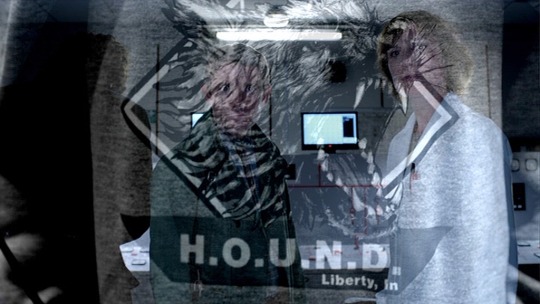

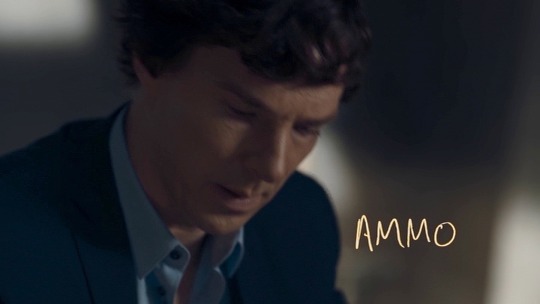

The thing with the ACRONYMS ...
Mycroft loves acronyms. All the best secret societies have them, he says. The creators of Sherlock BBC seem to love them as well, because several have found a way into their story. Reason enough to throw a brief glance at some of them. :)
TBC below the cut ...

UMQRA & HOUND
On the way to Dewer’s Hollow John notices flashes of light on the nightly moor. He interprets them as morse code signals for the letters U,M,Q,R,A and informs Sherlock about his discovery. When John follows those flashes of light, some hours later, he discovers a place where people engage in car-sex. What John expected to be morse code signals turns out to be just randomly blinking headlights of rocking cars. “Don’t be alarmed. It’s to do with sex” ...

Sherlock apparently doesn’t know about John’s second discovery and the rather trivial explanation for the mysterious flashlights on the moor. He experiments with the UMQRA letters, adds dots behind each one and suddenly has a revelation. He calls John ‘conductor of light’ and explains his idea. “What if it is individual letters?” Sherlock’s thoughts though are now focused on HOUND rather than UMQRA.

In a nutshell: UMQRA is linked to secret sexual activity in a car (body). By adding dots, Sherlock draws the connection from UMQRA to HOUND.
The monstrous HOUND, who allegedly haunts the Baskerville moore, changes into a simple dog.
H.O.U.N.D. turns out to be the name of a secret government project that got stopped a long time ago and had been now taken up again, illegally, by a doctor who is a virologist.
Affected by the HOUND-aerosol (love is in the air) ‘doctor’ and ‘virus’ - Frankland & Jim (’say hallo to the virus‘) - merge into one another in Sherlock’s mind. The ‘good’ doctor kills the dog. The ‘bad’ doctor dies in an explosion. Then Mycroft (the government/brain) releases Jim (’I’m Mr Sex’) from his prison. Big brother himself lets the HOUND off the leash ...
More on the same subject: UMQRA by @bug-catcher-in-viridian-forest - Are you attempting to make a point? by @221brainstorming (deleted) - Follow the Dog Part 2 by @sagestreet
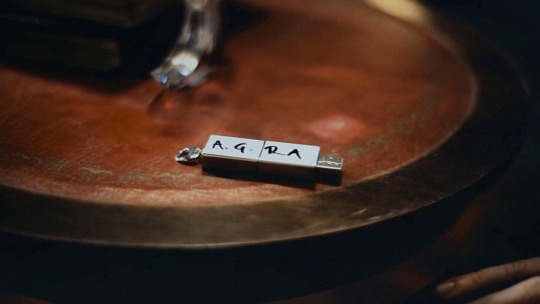
AGRA & AM(M)O
Mary tells Sherlock and John that the letters on her memory stick - AGRA - are meant to be her initials. Later it turns out that AGRA is an acronym, connected to a team of four agents - Alex, Gabriel, Rosamund Mary (alias Mary) and Ajay. This group was once employed by the government and Mary is still secretly working for Mycroft (TAB).
A code word is linked to the AGRA acronym, uttered by an anonymous voice on a phone. First Sherlock interprets that word as AMMO, short for ‘ammunition’. Some time later Sherlock realizes that this secret code word doesn’t mean ‘ammo’ but ‘amo’ ... Latin for ‘I love’.
Regarding the dots that accompany the AGRA acronym, there are some noticable irregularities:
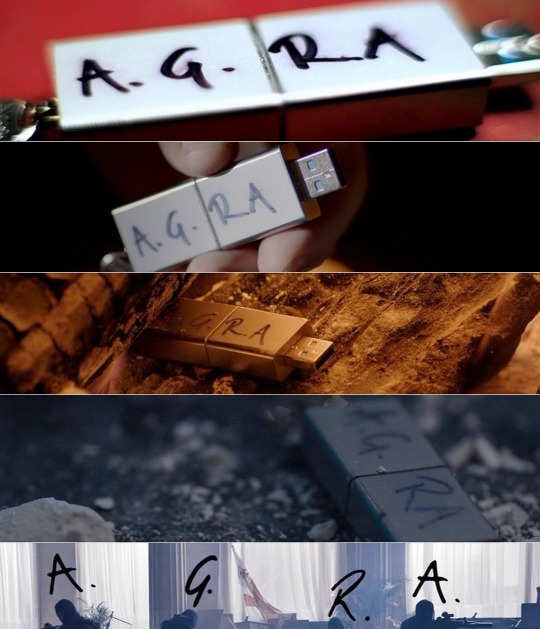
The memory stick Mary puts on the table in 221b (HLV) ... A.G.RA
John shows Mary her memory stick before he throws it into the fire at the Holmes cottage (HLV) ... A.G.RA
The memory stick in the fire (HLV) ... A.G.R.A
Ajay’s memory stick, revealed from inside the Thatcher bust (TST) ... A.G.RA
AGRA acronym at the beginning of the Tiblisi scene (TST) ... A.G.R.A.
And when Sherlock first mentions AGRA in Mycroft’s presence his brother instantly brings up the Indian city of Agra. No dots at all.
“Agra? A city on the banks of the river Yamuna in the northern state of Uttar Pradesh, India. It is three hundred and seventy-eight kilometres west of the state capital, ...”
THE CITY OF AGRA
This city plays a key role in AC Doyle’s novel The Sign of Four.
"The city of Agra is a great place, swarming with fanatics and fierce devil-worshippers of all sorts. Our handful of men were lost among the narrow, winding streets. Our leader moved across the river, therefore, and took up his position in the old fort at Agra. I don't know if any of you gentlemen have ever read or heard anything of that old fort. It is a very queer place,—the queerest that ever I was in, and I have been in some rum corners, too. First of all, it is enormous in size. I should think that the enclosure must be acres and acres. There is a modern part, which took all our garrison, women, children, stores, and everything else, with plenty of room over. But the modern part is nothing like the size of the old quarter, where nobody goes, and which is given over to the scorpions and the centipedes. It is all full of great deserted halls, and winding passages, and long corridors twisting in and out, so that it is easy enough for folk to get lost in it. For this reason it was seldom that any one went into it, though now and again a party with torches might go exploring.”
The old fort of Agra is the place where the theft of the great treasure takes place, around which Holmes’ case in The Sign of Four revolves. Somehow Doyle’s description of that fort ... fortress, palace and residence of rulers ... almost sounds like a description of a vast and convoluted mind palace.
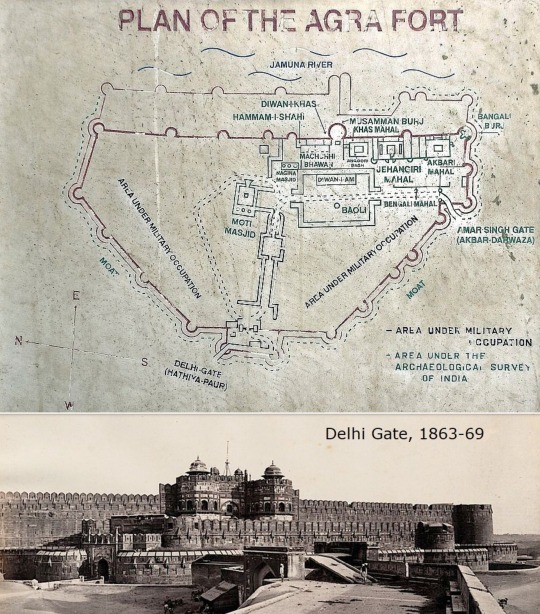
The great Agra treasure
This treasure gets stolen by a group of four men. They are bound by an oath - a vow - written down on paper and signed.
In the left-hand corner is a curious hieroglyphic like four crosses in a line with their arms touching. Beside it is written, in very rough and coarse characters, “The sign of the four” ...
A heavy iron box, made of Benares metal-work, contained the great treasure that consisted of ‘the most precious stones and the choicest pearls’:
There were one hundred and forty-three diamonds of the first water, including one which has been called, I believe, 'the Great Mogul' and is said to be the second largest stone in existence. Then there were ninety-seven very fine emeralds, and one hundred and seventy rubies, some of which, however, were small. There were forty carbuncles, two hundred and ten sapphires, sixty-one agates, and a great quantity of beryls, onyxes, cats'-eyes, turquoises, and other stones, the very names of which I did not know at the time, though I have become more familiar with them since. Besides this, there were nearly three hundred very fine pearls, twelve of which were set in a gold coronet. By the way, these last had been taken out of the chest and were not there when I recovered it.
The ‘Sign of Four’ and also Captain Morstan (Mary’s father) were later betrayed by Major Sholto, who took the treasure and ran off with it to England. And here the great treasure from the banks of the river Yamuna gets lost forever, submerged in the waters of the river Thames.
Great treasure from the banks ... lost ... the waters ...
At this point inevitably the Waters Gang from The Sign of Three comes to mind. This episode starts with three bank robbers, masked as clowns, who commit five thefts at almost quite regular intervals before they ..... get caught?
18 MONTHS AGO - “Bank gang leave cops clueless”
12 MONTHS AGO - “Who stole our two mill?”
6 MONTHS AGO - “Police are no closer to Waters Gang conviction”
3 MONTHS AGO - “Waters Gang walk free, again!”
YESTERDAY - Apparently no good day for the Waters family ... but then Sherlock phones, calls for help and Greg leaves his post ...
Is the Waters Gang able to escape again or do they get finally caught? That’s still an open question. And Mary’s secret A.G.R.A. identity will only be revealed in the next episode ... His Last Vow.
Points or no points ... or both?
Sherlock solves the Baskerville case by adding dots behind each letter of the word: HOUND ... H.O.U.N.D. The supernatural monster-hound disappears and turnes into a man-made project instead. Strictly speaking, however, both versions - the acronym H.O.U.N.D. as well as the word ‘hound’ - are important and have meaning and both are linked to Jim ‘Mr Sex’ Moriarty. Maybe this method applies also to AGRA?
AGRA without the dots
As Mycroft explains in The Six Thatchers, Agra is ‘a city on the banks of the river Yamuna in the northern state of Uttar Pradesh, India’. In AC Doyle’s novel The Sign of Four it is the old fort of Agra that plays the key role. The construction of this fortress - palace and residnece of rulers - was commissioned by emperor Shah Jahan (meaning: king of the world). Years later, Shah Jahan was put under house arrest in the Red Fort by one of his sons until his death in 1666. He found his final resting place in the same mausoleum he’d commissioned for his favourite wife Mumtaz Mahal. For eight years Shah Jahan looked out from the Red Fort at the place where his most favourite empress, his inseparable comanion, the great love of his life, had been laid to rest.
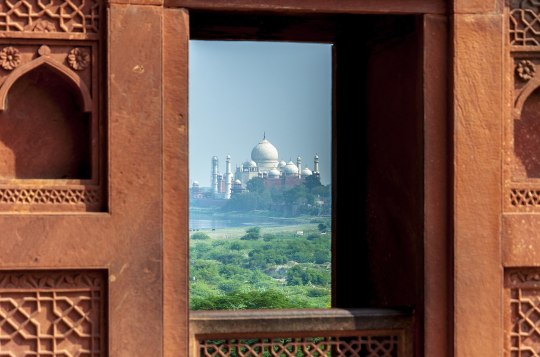
Agra’s most prized and best-known monument isn’t the old fort ... it is the Taj Mahal ... the worldwide renowned symbol of undying love.
The corners have been placed so that when seen from the center of the plan, the sun can be seen rising and setting on the north and south corners on the summer and winter solstices respectively. This makes the Taj a symbolic horizon. The planning and structure of the Taj Mahal, from the building itself to the gardens and beyond, is symbolic of the garden of Paradise. The sky has not only been incorporated in the design through the reflecting pools but also through the surface of the building itself.
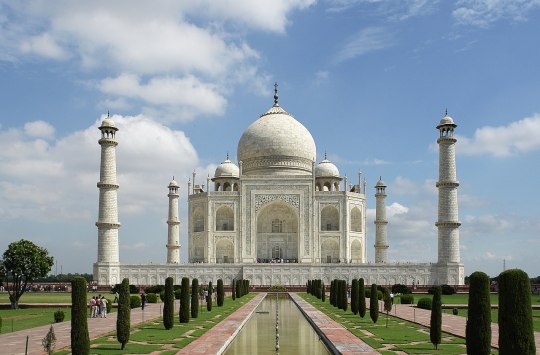
It is said that the white symbolizes the purity of real love. The planning of the entire compound has been split into two - representing earthly life and afterlife. The plan of the worldly side is a mirror image of the otherworldly side, and the grand gate in the middle represents the transition between the two lives.
AMO ... I love ...
A.G.R.A. or Agra - both versions finally lead to ‘love’ - just like H.O.U.N.D. and hound lead to ‘sex’. A virologist who is employed by the government but secretly works on his own project and a secretary, cleverer than most, who is also employed by the government and also does her own thing. Under the influence of the hound-aerosol the virologist merges visually with Jim and when the secretary’s secret amo-identity is unmasked, she uses - word for word - Jim’s line from TGG. Coincidence?
Lady Smallwoods codename is ‘love’ while Vivian Norbury calls herself ‘amo’ (I love). ‘Amo’ worked undercover, betrayed the government and used AGRA as her private assassination unit.
“Why did you betray us?” ..... “Why does anyone do anything?”

September, 2022
Thanks for reading and thanks @callie-ariane for the scripts.
Sources (incl. Agra pics): Agra Fort Taj Mahal Shah Jahan The sign of four by ACDoyle
#sherlock bbc#the thing with the acronyms#acronyms#umqra#hound#agra#ammo#amo#the sign of four#red fort#taj mahal#metaphorical reading
18 notes
·
View notes
Text



English - Hindi both of the languages.
.
On18/06/2022, a seminar on the topic 'LGBTQIA+ community and their challenges' was organized under the aegis of Indian Asexuals, Kanpur Queer Welfare Foundation and Shramik Bharti Sanstha.
Raj, the founder of Indian Asexuals, told various information related to the LGBTQIA+ community during the seminar and made the participants aware of their rights.
Founder of Kanpur Queer Welfare Foundation, Anuj Pandey said that he will work for the establishment of Kinnar Kalyan Board in Kanpur by the Uttar Pradesh government. Co-founder Md. Ahsan Ansari said that they'll soon provide shelter home to the LGBTQIA+ people in U.P.
Sadhna Ghosh, a senior worker of Shramik Bharti Sanstha, said that she will make the general public aware of the rights of the community and will try to connect the LGBTQIA + community with the mainstream.
She told everyone about the symptoms and treatment of HIV/AIDS.
At the end of the program participants shared what they learned and how they would change their behavior and make the LGBTQIA+ community feel safe. During the program Ganesh Pandey ji, Sanjay Kumari ji, Dr. Saif, Rishabh etc. were present.
.
दिनांक 18/06/2022 को इंडियन एसेक्सुअलस, कानपुर क्वीयर वेलफेयर फाउंडेशन एवं श्रमिक भारती संस्था के तत्वाधान में ॔ एलजीबीटीक्यू आई ए+ समुदाय एवं उनकी चुनौतियां' नामक विषय पर सेमिनार का आयोजन किया गया।
इंडियन एसेक्सुअलस के संस्थापक राज ने सेमिनार के दौरान LGBTQIA+ समुदाय से जुड़ी विभिन्न जानकारियों को बताया एवं प्रतिभागियों को उनके अधिकारों के प्रति जागरूक किया।
कानपुर क्वीयर वेलफेयर फाउंडेशन के संस्थापक अनुज पांडे ने बताया कि उत्तर प्रदेश सरकार के द्वारा कानपुर में किन्नर कल्याण बोर्ड की स्थापना कराने के लिए वह कार्य करेंगे। सह संस्थापक मो० अहसान ने कहा कि वह उत्तर प्रदेश में LGBTQIA+ समुदाय के लिए निवास गृह बनाने के लिए प्रयासरत है।
श्रमिक भारती संस्था की वरिष्ठ कार्यकर्ता साधना घोष जी ने कहा कि समुदाय के अधिकारों के प्रति आम जनता को जागरूक करेंगी एवं LGBTQIA+ समुदाय को मुख्यधारा से जोड़ने के लिए प्रयास करेंगी। सभी को HIV/Aids के लक्षण एवं उपचार के बारे में बताया।
13 notes
·
View notes
Photo

Pride Month 2021 ❤️🧡💛💚💙💜🤎🖤 Why it is okay not to come out (if you don't want to) By Khushee Kumar Designing By - Ananya Manvi- @ananyamanvi #pride #pridemonth #struggle #society #thoughtseal #pridemonth2021 #storyofjustice #lgbtqia+ #lovewins #rainbow #loveandqueer #queer #genders #mission #journey #justice #loveeveryone #love #rainbowwashing #equality (at Lucknow, Uttar Pradesh) https://www.instagram.com/p/CQnu_iZptio/?utm_medium=tumblr
#pride#pridemonth#struggle#society#thoughtseal#pridemonth2021#storyofjustice#lgbtqia#lovewins#rainbow#loveandqueer#queer#genders#mission#journey#justice#loveeveryone#love#rainbowwashing#equality
0 notes
Text
What’s currently happening in India
TW // rape, assault, death
I am just going to be restating what was said in this twitter thread. Please read it, it has a lot more details:
https://twitter.com/TXTOFFlCIAL/status/1351863397617262597
Rape has been a widespread problem forever. It’s not a new problem in India and it’s certainly not a problem confined to India. Rape never happens because of what the person is wearing and it is NEVER the victim’s fault. Now, to a few things that have happened recently.
Some parents are using corrective rape to “cure” their queer kids. Corrective rape is a practice in which a queer person is raped by a member of the opposite sex in order to “turn them straight”.
A 12 year old girl was found raped and murdered in Uttar Pradesh. She was found in the forest by her house on Tuesday.
A 14 year old girl was raped by 9 men. On January 11, two men who met her in a market took her into a forest and raped her. She shared what happened with a truck driver, Rohit Yadav, who also raped her. She was then raped by another truck driver who is unidentified; they are still searching for him. The girl reached her home on January 13 and informed the police.
A 17 year old girl was allegedly raped by 44 men over the course of 4 years. 33 were arrested and 29 cases were registered.
A more in depth article about this specific case -https://www.thehindu.com/news/national/kerala/17-year-old-sexually-abused-by-over-40-men-in-kerala/article33612964.ece
There have been countless cases of young girls, KIDS, being raped or murdered by older men. Please try to spread awareness. If I got any facts wrong, let me know, I will change it.
These are the petitions I could find. Do not donate to Change.org after you sign, the money doesn’t go to the cause.
https://www.change.org/p/supreme-court-of-india-india-against-rape-let-s-join-hands-to-fight-rape
http://www.thenewindia.org/stop-rape/
https://www.change.org/p/president-cji-stop-rape-now
#cw // death#cw // rape#cw // assault#india#rape#I know this isn’t something I have to say but please don’t be racist to South Asian people because of India’s rape crisis
0 notes
Text
UP Police Seals Borders in Efforts to Nab Gangster Vikas Dubey, Abandoned Cars Queer Pitch
UP Police Seals Borders in Efforts to Nab Gangster Vikas Dubey, Abandoned Cars Queer Pitch
[ad_1]

Representational Image: PTI
The Uttar Pradesh police have alerted their counterparts in adjoining states since it is believed that the gangster could be in hiding anywhere there.
IANS Lucknow
Last Updated: July 6, 2020, 12:30 PM IST
Even as gangster Vikas Dubey continues to elude the state police, the Uttar Pradesh police has stepped up its efforts to nab the man…
View On WordPress
#attack on police#kanpur encounter#kanpur killings#kanpur police killed#UP Police#uttar pradesh police#Vikas Dubey#vikas dubey gang
0 notes
Text
UP Police Seals Borders in Efforts to Nab Gangster Vikas Dubey, Abandoned Cars Queer Pitch
UP Police Seals Borders in Efforts to Nab Gangster Vikas Dubey, Abandoned Cars Queer Pitch
[ad_1]

Representational Image: PTI
The Uttar Pradesh police have alerted their counterparts in adjoining states since it is believed that the gangster could be in hiding anywhere there.
IANS Lucknow
Last Updated: July 6, 2020, 12:30 PM IST
Even as gangster Vikas Dubey continues to elude the state police, the Uttar Pradesh police has stepped up its efforts to nab the man…
View On WordPress
#attack on police#kanpur encounter#Kanpur killings#kanpur police killed#UP Police#uttar pradesh police#Vikas Dubey#vikas dubey gang
0 notes
Photo

In 2017 when I began making work in India I traveled to Lucknow, mostly to meet the distinguished Saleem Kidwai, whom I am now lucky to call a friend. I also came upon a wonderful group of young queer men and women who were, despite the fact that elections in Uttar Pradesh had just made the right wing Yogi chief minister, preparing their very first gay pride march. Not afraid of violence and backlash, they went for it. - As critically as I look upon Western models of the queer right movement being transplanted into the context of Indian history and culture, these men and women were quick to school me that without identities from the West ‘we have nothing, we are nobody. How can we build a community without these identities?’. #Stonewall is alive here as well, and it deserves respect and celebration everywhere, all the time. To our queer peers who paved the way for us and so many more! ❤️🌈#stonewall50 #samelove #pridemonth #stonewallriots #review #natpu #india #indianmen 🎬 📸 . . . . . . . . . . . . . #marcleclef #artistlife #artist #curator #portraitphotography #fineartphotography #contemporaryphotography #newphotography #analog #queerart #gay #dosti #gaydesi #documentaryphotography #artcollector #research #120film #visualart #filmphotography #contax645 #documentaryphotography #pridemonth #equality (at Lucknow, Uttar Pradesh) https://www.instagram.com/p/BzQIdI2lT_Q/?igshid=i39t13g4ukyq
#stonewall#stonewall50#samelove#pridemonth#stonewallriots#review#natpu#india#indianmen#marcleclef#artistlife#artist#curator#portraitphotography#fineartphotography#contemporaryphotography#newphotography#analog#queerart#gay#dosti#gaydesi#documentaryphotography#artcollector#research#120film#visualart#filmphotography#contax645#equality
0 notes
Text
Vikas Dubey case: Borders sealed, abandoned cars queer pitch
Picture Supply : GOOGLE Vikas Dubey case: Borders sealed, abandoned cars queer pitch Whilst gangster Vikas Dubey continues to elude the state police, the Uttar Pradesh police have stepped up its efforts to nab the person who’s the principle accused within the killing of eight police personnel in Kanpur on Friday. Whereas vigil has been […]
The post Vikas Dubey case: Borders sealed, abandoned cars queer pitch appeared first on CityNews360.
from WordPress https://ift.tt/2ZV9Bxh via IFTTT
0 notes
Link
via Today Bharat nbsp; On paper, the Government of India doesnrsquo;t want to come across as problematic, for the most part. Whether itrsquo;s the Citizenship (Amendment) Act, or the ldquo;Rightsrdquo; of Transgender Persons Act, there is great care taken by the political leaders of this country (or their bureaucrats) to ensure that, on paper, they use the right words and say the right things. Two recent ldquo;writtenrdquo; documents from the government prove this: the first, an RTI reply to activist Saket Gokhale that said the Ministry of Home Affairs has no information regarding the lsquo;tukde tukde gangrsquo; ndash; a term that even the Home Minister himself has used to identify critics of the government. The second, is a reply in the Lok Sabha, where the Ministry of Home Affairs (once again) has said that there is no legal definition of the term lsquo;Love Jihadrsquo;. On paper, this government wants us to believe that everything is hunky-dory and going as per the Constitution of India. But whatrsquo;s lsquo;on paperrsquo; in the narrow sense hardly matters, in reality. And thatrsquo;s why, whatever they might put lsquo;on paperrsquo; should not be a celebration of victory. Take for instance the term lsquo;tukde tukde gangrsquo;, or lsquo;urban naxalrsquo;. The government doesnrsquo;t need to recognise these terms for the right-wing ecosystem fuelled by tacit approval from the government to identify and target people as such. To every dissenter who has either been arrested or is facing sedition charges ndash; whether itrsquo;s Sudha Bharadwaj or the 50 young queer people in Mumbai who raised slogans in support of Sharjeel ndash; it doesnrsquo;t matter if the Ministry of Home Affairs has officially lsquo;identifiedrsquo; a lsquo;tukde tukde gangrsquo;. Itrsquo;s enough that the police force in the country has internalised that dissent is criminal ndash; and lsquo;anti-nationalrsquo;. And while the government might, lsquo;on paperrsquo; in an RTI reply say that they donrsquo;t have any details of a lsquo;tukde tukde gangrsquo; ndash; will they ever tell Arnab Goswami to stop using the term, or tell the right-wing ecosystem to stop targeting people using the term? Will they ever tell the hordes on the streets and online that lsquo;Love Jihadrsquo; doesnrsquo;t actually exist according to law ndash; or that, lsquo;on paperrsquo;, the government stands by Article 25 of the Constitution that guarantees right to freedom of religion to all citizens? Especially when the very idea of lsquo;citizenshiprsquo; is going through a seemingly ugly metamorphosis? The short answer is no. Letrsquo;s take Yogi Adityanath for instance ndash; the saffron clad Chief Minister of Uttar Pradesh who seems to have a bunch of friendly advice for his counterparts in more developed states, never mind the condition of his own backyard. When the BJP brought him in as a lsquo;star campaignerrsquo; to Kerala, Yogi raised the bogey of lsquo;Love Jihadrsquo;, and said, "Love Jihad is a dangerous thing and the Kerala government should make its stand clear about it." The right-wing ecosystem meanwhile has bandied the term about so much, itrsquo;s shameful. The VHP in fact held a workshop for parents on how to stalk their children in order to stop lsquo;Love Jihadrsquo;. In one of the sickest manifestations of this form of communal warfare, people who self identified with the right-wing in Kerala launched a social media campaign in December 2019 against couples who were about to marry. The ecosystem managed to destroy the privacy of individuals and put their safety at risk by putting out photos and personal details of scores of interfaith couples, where the man was a Muslim. So while the government says, on paper, ldquo;Article 25 of the Constitution provides for the freedom to profess, practice and propagate religion subject to public order, morality and health. The term lsquo;Love Jihadrsquo; is not defined under the extant laws,rdquo; their supporters go around denying people their freedoms. Perhaps the height of this tasteless campaign against interfaith marriages and right to freedom of religion, is the witch hunt of Hadiya. An adult woman who chose to convert to Islam was hounded by right wingers across the country, including Uttar Pradesh Chief Minister Yogi Adityanath. "Supreme Court has already observed that love jihad exists in Kerala and Karnataka through various judgments. But, Kerala has not taken effective steps to control it. Hadiya case itself is an evidence of love jihad," Adityanath had said. Never mind that Hadiya chose to convert first, and then married a Muslim man chosen for her by her guardian. Never mind that it wasnrsquo;t even a lsquo;love marriagersquo;. But the hordes that herald hate had subjected Hadiya to a vicious campaign ndash; because, unlike the Ministry of Home Affairsrsquo;s lsquo;on paperrsquo; stand, the right-wing ecosystem does not care for Article 25 of the Constitution.
0 notes
Text
Gay in Gorakhpur: What it means to be a queer person in small-town Uttar Pradesh https://t.co/8njPzUVGQM via @IndianExpress
— LGBTQ India News (@LgbtqIndia) August 5, 2018
0 notes
Text
A male Belly Dancer's passionate struggle against all odds
“Is this the way to Eshan Hilal’s house?”, I ask two teenagers perched on a balcony in a narrow street of East Delhi. “The belly dancer?” comes a reply laced with sarcasm, followed by laughter. “”Yes”. Two other people I stop for directions also snigger at me before I find myself sitting in a small room on the roof of a house, on the hot Thursday afternoon. 24-year-old Eshan Hilal is like any other young Pathan man-- tall, lean and sharp-featured-- but his profession and his gender fluid dressing sets him apart in many ways, to the point of being called “feminine” by some and a “Kafir” by some others. Eshan is a belly dancer or how people usually put it, a male belly dancer. A tag he doesn’t want for himself. Adorned in oxidised silver jewellery, a flowy black skirt and a kurta rolled up to expose his belly, Eshan steps out of his room in the sweltering heat to practice for the auditions of an upcoming dance reality show. He isolates his body movements and sways with the music. Nothing looks “feminine” about his dance. His belly dance, however, seems to be on point. His turns are sharp and his eyes focussed, deep and expressive. As we sit to talk, he pulls out a bunch of photos of Bollywood actress Madhuri Dixit. Someone who has inspired scores of girls in India to dance. She inspired Eshan too. In fact, one cannot miss the glimpses of her style in Eshan’s belly dance. “Dance is something which I started doing from my childhood. I started learning Kathak because I was a huge fan of Madhuri Dixit. I was so much into Kathak, travelling, performing and doing events but there was a void space,” he says. He was talking about freedom of movement, and above all, he was looking for the freedom within to accept his interests. “In Kathak, you can’t move your hips, it is called Badtamaeezi. I came across a lot of male belly dancer videos on YouTube and fell in love with the dance form,” he says. But the road to becoming a professional belly dancer was not easy. Eshan comes from an orthodox Muslim family, where dancing is not a fitting profession, especially for a man. “My parents say dancing is a Taboo in my religion. It is Haram. They never stopped me as a kid thinking I’ll give up dance when I grow up. They thought I would realise how girlish dancing was. But when I told them I wanted to be a choreographer, they asked me to quit.” He didn’t. For about eight months now his parents and younger siblings--a brother and two sisters--haven’t been talking to him. They live in the same house but Eshan has a separate portion for himself. “My father says dancing belongs to a category where you entertain people. We don’t entertain, we get entertained.” Eshan says. When I meet his father, Eshan stands outside on the steps of his part of the house, listening to our conversation. “Dancing is dirty. Our religion doesn’t allow it. It is Haram. Even a rupee that he earns through dancing is Haram for us. We will never support him.” Mohammad Hilal (50) says. Back in their village in eastern Uttar Pradesh, family members taunt Eshan’s parents saying his son has become a “nachaniya”, a derogatory term used for female dancers. This doesn’t go down well with Mohammad. “I have tried telling them that there is nothing feminine about it.Your body is moving to a sort of music. How can you call this feminine? There are no gender roles in art forms. No such published book that says that. Since childhood, I have been listening to these things. Don’t cross your legs and sit because girls do that. Don’t use so much of your hands while talking because girls do that. There was a constant comparison between me and my brother. He was the normal one and I, an abnormal. I never understood that. Belly Dance gave me solace from these things.” Eshan says. His struggle to separate his gender from his dance is not just limited to family, friends and the society. Even in his world of escape, there are stereotypes he has had to fight. Belly Dancing in India is still not considered a proper art form. Many call it vulgar. And it is mostly associated only with women. “People are quite uninformed about belly dance here in India. When women perform belly dance they are labelled by some people as characterless. In the case of a man, people question his sexuality. Just because I am a belly dancer, people call me queer and gay. I don’t understand how the choice of a dance form that I perform defines my sexuality. If I was doing hip hop or some other dance form that is considered masculine. The scenario would be different.” he says. This was perhaps one of the reasons why dance schools in India were not ready to teach Eshan Belly dance. He says he approached a famous school for five years till they were finally ready to take him in. “I tracked so many schools in Delhi and Mumbai. So many popular dance schools outrightly refused to take me in. They said they don't teach belly dance to men.” He says. Many male belly dancers here take to cross-dressing. Eshan says this practice further fuels the gender stereotypes. “Often people ask me why don't macho and masculine men opt for belly dancing. They do. If you see al these American, Egyptian and Chinese belly dancers they are so masculine and macho. They are married and have kids and they are belly dancers. And they wear those proper male sharky costumes.” he says. “There are so many boys in India who cross-dress. They wear fake wigs and bralettes and they dress up like women and perform in public spaces and call themselves male belly dancers. Which is absolutely wrong and leaves a wrong impression of the art that belly dance is.” Over the years Eshan has learnt to not let prejudices impact his interests. Fashion designing is one of his hobbies. He likes designing clothes that are gender fluid, a form of dressing he himself has embraced. He started wearing heels designed for men when he was 20, became androgynous in his dressing and belly dancing he says gave him liberty. “Since childhood, I was a very spineless sort of a guy. Very perplexed. I though I have some issues in me and that’s why my parents scold me and the society teases me. I always thought I was wrong and they were right but I explored myself through this dance form and realised there is nothing wrong with me. It's just the perception of the people who can’t take different things.” he says. Eshan now earns a living by teaching kids belly dance and occasionally doing wedding choreography. He now looks forward to making a name in the world of belly dance. He says the only dream that now remains is winning the love and support of his parents. “My only achievement will be when my family accepts me for who I am publicly and proudly says he is our son. He is a belly dancer.”
(WION)
]]>
0 notes